
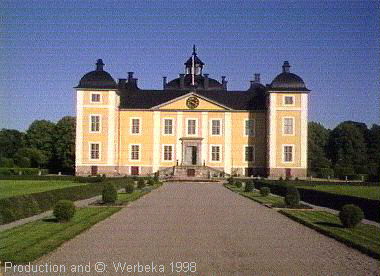 .
.
THE CASTLE OF STRÖMSHOLM
© Bernhard Kauntz, 1998
The village of Strömsholm is situated about 20 km to the southwest of Västerås and it is well known for its riding-school and its hospital for animals.
The castle of Strömsholm is one of eight castles, which are free to be used by the Royal family. Gustav Vasa ordered to build the first "fortified house" on this spot, in the middle of the 16th century. In 1669 today's castle was built after the instructions of Queen Hedwig Eleonora. The drawings were made by Nicodemus Tessin Sr., who found a similar architectural solution for the Castle of Drottningholm.
Hedvig Eleonora, the mother of Karl XI, is responsible for a lot of other buildings in the vicinity of the castle, a couple of which - the inn and the page-building, to mention some - still can be seen today.
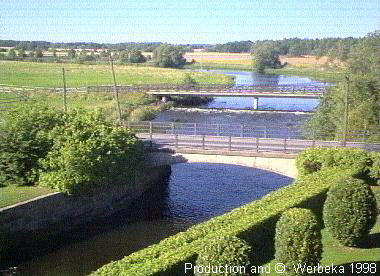 Spacious gardens are part of the castle, but their shape has varied through the centuries. Inside the castle the rooms are placed almost symmetrically around a central staircase, leading upwards around a small open-aired shaft.
Spacious gardens are part of the castle, but their shape has varied through the centuries. Inside the castle the rooms are placed almost symmetrically around a central staircase, leading upwards around a small open-aired shaft.
Already in the 1730's the castle showed the first signs of decay, which led to a restauration by Ulrika Eleonora Jr., the youngest sister of Karl XII. But thereafter the interest for the Castle of Strömsholm sunk low again, until it was given to Sofia Magdalena by Gustav III, as a wedding gift. Then the restauration was continued and some minor changes were made to the building in the later part of the 18th century.
After the invention of the railroad the castle lost its value as a place to stay overnight and from 1868 onwards the new riding school of the cavalry was allowed to use parts of the castle, e.g. as boarding school for the pupils. Exactly one century later the military part of the riding school was discontinued and today the castle suits as a museum.
The first thing I notice, when I get closer, is that a huge caterpillar is standing right in front of the stairway. It diminishes the urge to take a photo right away, but that doesn't matter too much, because the sun will stand in a better position the later I take that picture of the castle's front.
The next thought hitting me, is that the "Kolbäcksån, the small river, makes an outstandingly beautiful and natural moat in front of the entrance on the west side of the building.
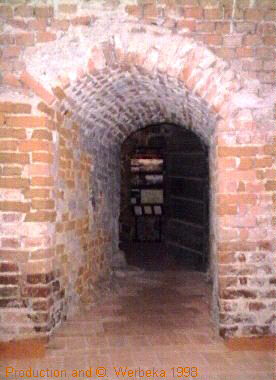 Walking across the bridge I can see a portlet to the right of the staircase, behind which some steps lead down to the cellar. An exhibition is shown there, about the gardening arrangements throughout the castle's history. This isn't exactly my field of interest, but I enjoy it anyhow, taking a stroll in those dusky, almost dark vaults of the cellar.
Walking across the bridge I can see a portlet to the right of the staircase, behind which some steps lead down to the cellar. An exhibition is shown there, about the gardening arrangements throughout the castle's history. This isn't exactly my field of interest, but I enjoy it anyhow, taking a stroll in those dusky, almost dark vaults of the cellar.
Coming back into daylight I notice a man, who could be the gardener and in this position also responsible for the caterpillar. I tell him that his vehicle disturbs my sense of aesthetics, but he replies jokingly that the caterpillar might be worth more than the entire castle. But he promises to move it anyway.
I ascend the stairs to the entrance of the castle, where I am supposed to pay 30 crowns fee. This tribute would not only give me the right to enter the castle, but also the cellar. With a big smile I explain that I'm just coming from there....
At the book-board near the reception I get some literature about the castle and its former inhabitants - this might prove useful, when writing a report about this excursion. Besides, one might always learn something new as well.
Then I start my exploration. Through the outer dressing-room I reach the northwestern tower-room, which, according to description, was used as a guest-room for the Queens visitors.
Talking about description... This consists of more or less shabby pieces of paper with information about the room and its furniture, hung at the entrance of the room or lying on some chair or chest. Of course it is a good thing that there is such a description, but why not in a more civilized form - and why only in Swedish?
In the next room - the Queen's dressing-room, spacious as one half of my apartment - I finally recognize that I am going into the wrong direction, as the decreasing room-numbers indicate. But however, that might happen to anybody and I don't feel like starting all over again. That is why I now respectfully enter the Queen's bedroom.
And yes, this dark red bed (I learn that it is of carmine damask) is worthy of a Queen. It might be that it is the original imperial bed, according to the information. The parquett floor of oak is the original from the 18th century as well, installed during Sofia Magdalena's reign.
A parquett floor can be found in the next room as well, the audience-chamber of the Queen, whereas the other rooms have plain deal floors. This enormous room could be divided by two curtains, which would shield a corridor from the Queen's bedroom to the northeastern tower-room. On the ceiling you can still see how and where the curtains were fastened.
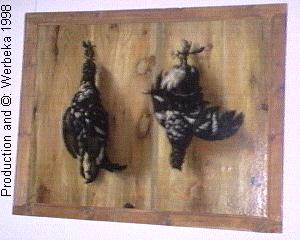 In the following Chamber of Portraits there are paintings of the Swedish monarchs from Gustav Vasa until Karl XIV Johan, as well as a bust of Sofia Magdalena made by the famous sculptor Sergel. The Chamber of Portraits is the largest room on the lower floor. The furniture is sparse, as in the entire castle. This certainly depends partly on removement of some pieces during the centuries, but partly also on the fact that the castle never became fully furnitured. This was due to the lack of money as well as the lack of interest.
In the following Chamber of Portraits there are paintings of the Swedish monarchs from Gustav Vasa until Karl XIV Johan, as well as a bust of Sofia Magdalena made by the famous sculptor Sergel. The Chamber of Portraits is the largest room on the lower floor. The furniture is sparse, as in the entire castle. This certainly depends partly on removement of some pieces during the centuries, but partly also on the fact that the castle never became fully furnitured. This was due to the lack of money as well as the lack of interest.
Next to go is the Chamber of the Crown Prince, even if it isn't made clear which Crown Prince is intended. Here too, a royal bed in red damask is dominating the room - but in my eyes, the overwhelming thing is the painting of Ehrenstrahl, showing two blackcocks against a wooden wall.
The following southeastern tower-room and its antichambre, like all the others, was used as guest-rooms, probably for friends of our unspecified Crown Prince.
Here I find some paintings by the mother of Karl XII, Queen Ulrika Eleonora the elder, which are very well made. I can't stop being surprised at the talents of that poor Danish woman, who refused a proposal by the German Emperor Leopold I, only because she was engaged to the Swedish King Karl XI, even if he at that time made war on the Danish. Later on, through her marriage, she became primarily a stone in a political game, in which she was to guarantee peace between Denmark and Sweden. Within her marriage it was her most important duty to conceive children, seven in all, in as many years - but not even half of them lived to reach adult age. Add the fact that the vixen she had as a mother-in-law dominated her marriage and that she had to die at an age of only 37, then you could talk about a tough destiny. Still, this woman had such outstanding talants in painting....
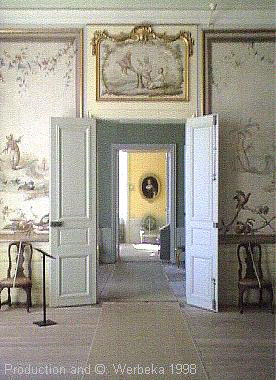 The main room at the southern side is the Chinese Dining-room. Its name clearly comes from the wallpaintings by Lars Bolander, all in Chinese style, accomplished after French model in 1774. In the inventory of 1818 there are mentioned four dozen dining-room chairs among the furniture.
The main room at the southern side is the Chinese Dining-room. Its name clearly comes from the wallpaintings by Lars Bolander, all in Chinese style, accomplished after French model in 1774. In the inventory of 1818 there are mentioned four dozen dining-room chairs among the furniture.
The photo to the right was taken standing in the Chinese Dining-room, against the southwestern tower-room. The portrait to be seen there was made by Ehrenstrahl's successor as a royal painter, David von Krafft. The preceding room and the tower-room itself hold the original furniture as given in the inventory of 1816. They were used as guest-rooms as well.
The last room on this floor, before I have completed my circle, coming back to the entry hall, has been a guardroom. Today there is a large cupboard in which a lot of gadgets are shown, which were in use in Strömsholm, mainly during the 19th century.
After having climbed the staircase I have learned my lesson about the sequence of the rooms and I turn south towards the Chamber of State. The walls of this large room, using the entire length of the castle to the south, are hung with paintings by Ehrenstrahl, showing the horses of Karl XI, almost in natural size. That this room, through the time of the riding school, was used as its gymnasium, is almost a sacriledge.
The central room on the eastern side is also dominated by memories of the riding school, it was used as the Club. Here some more horses of Karl XI are shown, as well as two allegorical paintings by Ehrenstrahl.
The King's audience-chamber is coming next and here is another painting by Ehrenstrahl. It is a very large one, showing the coronation of Karl XI in the Cathedral of Uppsala. The northeastern tower-room is used as an example of a store room, in this case storing old furniture, most of it from the end of the 17th century. Among other things there are the beds of Karl XII and his sister Hedvig Sofia, from 1694.
The King's bedroom is the central room to the north, right above the Queen's bedroom. I find this a rather bad solution, until I find out that there is a "secret" staircase leading down...
Through the last room, the King's dressing-room, I reach the central staircase again. I ascend another floor, where the chapel is supposed to be, but I find only locked doors. I read that Queen Ulrika Eleonora the younger had ordered Carl Hårleman to plan the chapel in the 1730's and that most of the furniture still remains from that time.
In spite of the bad luck with the chapel (though I am sure, that I could have gained access, if I only had asked for it), I feel full of impressions and find that the entrance-fee was well spent, when I leave the building. The caterpillar has been moved now, as promised, and I get my picture of the front view, before climbing my bike and pedalling homewards, in my mind sorting out all the new experience.
Back to the  , the , the  or to the
or to the  of of 
last update: 5.10.1998 by
webmaster@werbeka.com
|

 .
. , the
, the  or to the
or to the  of
of 
 Spacious gardens are part of the castle, but their shape has varied through the centuries. Inside the castle the rooms are placed almost symmetrically around a central staircase, leading upwards around a small open-aired shaft.
Spacious gardens are part of the castle, but their shape has varied through the centuries. Inside the castle the rooms are placed almost symmetrically around a central staircase, leading upwards around a small open-aired shaft. Walking across the bridge I can see a portlet to the right of the staircase, behind which some steps lead down to the cellar. An exhibition is shown there, about the gardening arrangements throughout the castle's history. This isn't exactly my field of interest, but I enjoy it anyhow, taking a stroll in those dusky, almost dark vaults of the cellar.
Walking across the bridge I can see a portlet to the right of the staircase, behind which some steps lead down to the cellar. An exhibition is shown there, about the gardening arrangements throughout the castle's history. This isn't exactly my field of interest, but I enjoy it anyhow, taking a stroll in those dusky, almost dark vaults of the cellar. In the following Chamber of Portraits there are paintings of the Swedish monarchs from Gustav Vasa until Karl XIV Johan, as well as a bust of Sofia Magdalena made by the famous sculptor Sergel. The Chamber of Portraits is the largest room on the lower floor. The furniture is sparse, as in the entire castle. This certainly depends partly on removement of some pieces during the centuries, but partly also on the fact that the castle never became fully furnitured. This was due to the lack of money as well as the lack of interest.
In the following Chamber of Portraits there are paintings of the Swedish monarchs from Gustav Vasa until Karl XIV Johan, as well as a bust of Sofia Magdalena made by the famous sculptor Sergel. The Chamber of Portraits is the largest room on the lower floor. The furniture is sparse, as in the entire castle. This certainly depends partly on removement of some pieces during the centuries, but partly also on the fact that the castle never became fully furnitured. This was due to the lack of money as well as the lack of interest. The main room at the southern side is the Chinese Dining-room. Its name clearly comes from the wallpaintings by Lars Bolander, all in Chinese style, accomplished after French model in 1774. In the inventory of 1818 there are mentioned four dozen dining-room chairs among the furniture.
The main room at the southern side is the Chinese Dining-room. Its name clearly comes from the wallpaintings by Lars Bolander, all in Chinese style, accomplished after French model in 1774. In the inventory of 1818 there are mentioned four dozen dining-room chairs among the furniture.